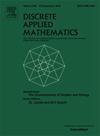On the edge-connectivity of the square of a graph
IF 1
3区 数学
Q3 MATHEMATICS, APPLIED
引用次数: 0
Abstract
Let be a connected graph. The edge-connectivity of , denoted by , is the minimum number of edges whose removal renders disconnected. Let be the minimum degree of . It is well-known that , and graphs for which equality holds are said to be maximally edge-connected. The square of is the graph with the same vertex set as , in which two vertices are adjacent if their distance is not more that 2.
In this paper we present results on the edge-connectivity of the square of a graph. We show that if the minimum degree of a connected graph of order is at least , then is maximally edge-connected, and this result is best possible. We also give lower bounds on for the case that is not maximally edge-connected: We prove that , where denotes the connectivity of , i.e., the minimum number of vertices whose removal renders disconnected, and this bound is sharp. We further prove that , and we construct an infinite family of graphs to show that the exponent of in this bound is best possible.
求助全文
约1分钟内获得全文
求助全文
来源期刊

Discrete Applied Mathematics
数学-应用数学
CiteScore
2.30
自引率
9.10%
发文量
422
审稿时长
4.5 months
期刊介绍:
The aim of Discrete Applied Mathematics is to bring together research papers in different areas of algorithmic and applicable discrete mathematics as well as applications of combinatorial mathematics to informatics and various areas of science and technology. Contributions presented to the journal can be research papers, short notes, surveys, and possibly research problems. The "Communications" section will be devoted to the fastest possible publication of recent research results that are checked and recommended for publication by a member of the Editorial Board. The journal will also publish a limited number of book announcements as well as proceedings of conferences. These proceedings will be fully refereed and adhere to the normal standards of the journal.
Potential authors are advised to view the journal and the open calls-for-papers of special issues before submitting their manuscripts. Only high-quality, original work that is within the scope of the journal or the targeted special issue will be considered.
 求助内容:
求助内容: 应助结果提醒方式:
应助结果提醒方式:


